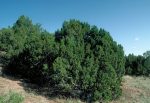 Also called one-seeded juniper, this evergreen coniferous shrub or small tree is native to the mountains of southwestern US including Arizona, New Mexico, southern Colordo, panhandle of Oklahoma, and western Texas where they grow on dry sandy or rocky slopes. It is a member of the Cypress family, Cupressaceae, that also includes redwoods. Plants grow up to 50′ tall from a deep root system and are multistemmed, densely branched, and may be knarled. Stems have reddish brown to gray-brown bark that exfoliates in thin longitudinal strips to expose bright orange brown beneath. Young foliage is needle-like while mature leaves are scale-like. In spring male and female berry-like cones are produced on different plants. Female plants produce berry-like fruits that are black to copper-colored with waxy bloom, contain one seed and are eaten by birds and small mammals. Cherrystone juniper is extremly drought tolerant once esptablished and is an excellent choice for erosion control or a screen especially in a xeriscape. The genus name, Juniperus, is the ancient Latin name for the plant. The specific epithet, monosperma, comes from the Greek words, monos meaning single and the sperma, meaning seed and refers to the fruit.
Also called one-seeded juniper, this evergreen coniferous shrub or small tree is native to the mountains of southwestern US including Arizona, New Mexico, southern Colordo, panhandle of Oklahoma, and western Texas where they grow on dry sandy or rocky slopes. It is a member of the Cypress family, Cupressaceae, that also includes redwoods. Plants grow up to 50′ tall from a deep root system and are multistemmed, densely branched, and may be knarled. Stems have reddish brown to gray-brown bark that exfoliates in thin longitudinal strips to expose bright orange brown beneath. Young foliage is needle-like while mature leaves are scale-like. In spring male and female berry-like cones are produced on different plants. Female plants produce berry-like fruits that are black to copper-colored with waxy bloom, contain one seed and are eaten by birds and small mammals. Cherrystone juniper is extremly drought tolerant once esptablished and is an excellent choice for erosion control or a screen especially in a xeriscape. The genus name, Juniperus, is the ancient Latin name for the plant. The specific epithet, monosperma, comes from the Greek words, monos meaning single and the sperma, meaning seed and refers to the fruit.
Type: Evergreen tree
Outstanding Feature: Drought tolerance
Form: Rounded
Growth Rate: Slow
Bloom: Male and female cones on different plants in spring
Size: up to 50′
Light: Full sun
Soil: Average, dry to medium moist, well-drained, neutral to acid
Hardiness: Zones 4-8
Care: Prune any t ime of year to shape or control size.
Pests and Diseases: Rust, fungal blight, spider mite, twig girdler, scales
Propagation: seed, cuttings, layering, grafting
Photo Credit: Wikipedia